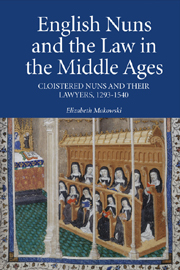Book contents
- Frontmatter
- Contents
- Preface
- Acknowledgments
- List of Abbreviations
- Introduction
- I Clients and Lawyers
- 1 Cloistered Spirituality and English Nuns
- 2 Legal Professionalism and English Lawyers
- 3 Letters of Appointment and Routine Business
- II Select Cases
- Conclusion
- Appendix
- Select Bibliography
- Index
- Titles in the series
1 - Cloistered Spirituality and English Nuns
from I - Clients and Lawyers
Published online by Cambridge University Press: 05 April 2013
- Frontmatter
- Contents
- Preface
- Acknowledgments
- List of Abbreviations
- Introduction
- I Clients and Lawyers
- 1 Cloistered Spirituality and English Nuns
- 2 Legal Professionalism and English Lawyers
- 3 Letters of Appointment and Routine Business
- II Select Cases
- Conclusion
- Appendix
- Select Bibliography
- Index
- Titles in the series
Summary
Worn down by a long property dispute which had depleted the community's resources, Abbess Joan Keteryche (1459–1479) of the Franciscan Abbey of Denney wrote a letter to her relative and patron, John Paston. It was an importunate letter that ended with this reminder: “Consydre how we be closyd withynne the ston wallys, and may no odyr wyse speke with you but only be wrytynge.”1 Hoping to persuade Paston to assist her, the abbess had needed to strike just the right rhetorical note and did so by mentioning the fact of her strict enclosure. It hardly signified that, by virtue of a papal mandate issued over a century earlier, every abbess in England as well as on the continent should have faced similar constraints. To remind her kinsman of the distinctive, strict, nature of enclosure at Denney was to gain much-needed leverage.
As Joan Keteryche knew well, the cloistered spirituality of the mendicant nuns of Denney was not typical of late medieval English nuns, notwithstanding a concerted papal attempt to make it so. That attempt began with the well-known 1298 decree of Pope Boniface VIII, Periculoso. Substituting the inflexible papal will for flexible local prerogative, in language reminiscent of his more famous decrees, Periculoso applied the law of enclosure to “nuns of every community or order, in every part of the world, both collectively and individually.”
- Type
- Chapter
- Information
- English Nuns and the Law in the Middle AgesCloistered Nuns and their Lawyers, 1293–1540, pp. 11 - 28Publisher: Boydell & BrewerPrint publication year: 2012



